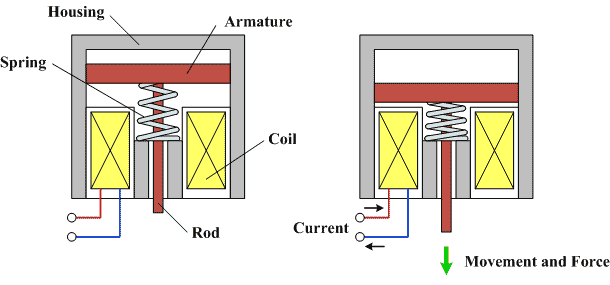Solenoids
- Basic Description
-
Solenoids convert electric energy into linear motion. A typical solenoid
consists of a coil, armature, actuating rod and spring. The armature and rod are connected
to the housing through the spring and stay at the equilibrium point when the solenoid is off.
When current flows through the coil, a magnetic force is generated that pulls the armature downward.
When the current is cut off, the spring force pushes the armature and rod back to their initial positions.

Solenoids typically respond faster than pneumatic or hydraulic actuators.
Many solenoids are designed for simple on and off applications, such as automobile starter
solenoid and door locks. Other solenoids are designed to offer precise control of the rod
position by regulating the amount of current in the coil.
- Manufacturers
- Bicron, Deltrol Controls, Ross Decco, Hitachi, Johnson Electric, Lisk, Magnetic Sensor Systems, Magnet Schultz, Moog, The Solenoid Company, Trombetta
- For More Information
- [1] Solenoid,
Wikipedia.
- [2]
Current Measurement in Solenoids for Automotive Control Systems,
Scott Beversdorf and Chuck Whiting, Analog Dialogue 38-04, April, 2004. (pdf)
- [3] Direct-Acting Solenoid Valve Animation, YouTube, Dec. 30, 2007.
- [4] Solenoid Valve How It Works, YouTube, Aug. 2008.
- [5] DSN Animation: What is a Solenoid Valve?, YouTube, Dec. 29, 2010.
|

